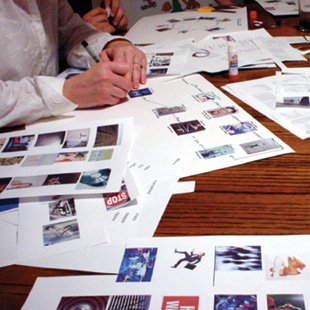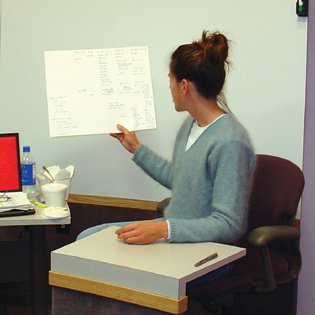Research Methods
| Design research has many methods, drawn from other disciplines or created by designers over the years. These methods can be roughly divided into three categories: observations, interviews, and activities, including having subjects make things and self-report on their activities. Whole books have been written on the methods of design research, so we will discuss only a representative sample here. ObservationsThe easiest and possibly the most fruitful of all design research methods is simply observing what people are doing. Designers can covertly watch or interact with people or tag along with subjects to ask them questions about how and why they are doing what they are doing.
When conducting observations, dress not to impress. The point is to blend in with the environment so that the observer isn't the one being observed. Observers should wear neutral, nondescript clothing that is appropriate to the environment. The more observers look like they belong, the more they'll become part of the background. Bring props if necessary. Some environments require certain items for the observer to seem normal, such as a backpack in school settings, a hard-hat on construction sites, or a suit in a conservative office. Observers should choose their locations wisely and be willing to change to another one if the original doesn't seem to be yielding good results. Observers should sit or stand in places where they can observe without being noticeable. It's best to be at an angle when observing subjects instead of directly in front or back of them, because an angle gives a clearer line of sight. Camera phones are excellent for inconspicuously snapping photos in public spaces. Remember, however, that any such photos should be used in an ethical manner. InterviewsIt's amazing what you can find out if you just ask. Talking to people and hearing their stories is a great way to uncover attitudes and experiencesbut designers do need to be careful: what people say they do and what they actually do are typically two very different things. Here are some methods for talking to users:
Figure 4.1. A desk tour can reveal how people structure their personal space to work.
When talking to subjects, it's best to have what the Buddhists call the "beginner's mind." Designers should be open and nonjudgmental and should not assume that they know the answer beforehand. Simple questions can reveal powerful answers. When possible, designers should avoid questions that can be answered with a yes or no; instead focus on drawing out stories and answers to how, what, and why questions. ActivitiesA recent trend in design research calls for designers to not only observe and talk to users, but also to have them engage in an activity that involves making an artifact. This process allows designers to draw out emotions and understand how people think about a subject. Doing activities frees subjects' creativity and allows them to express themselves differently than they would in an interview. Here are some methods for making artifacts with subjects:
Figure 4.2. Creating collages can give visual and verbal clues as to how subjects think and feel about a topic.
Figure 4.3. Drawing experiences can bring out subjects' hidden experiences and emotions.
An important part of having subjects make things is having them explain their choices after they are done (Figure 4.4). Otherwise, the designer may be left with a perplexing object and no way of understanding it. Ask, for instance, why a subject chose negative words in the collage or why a subject built the robot that way. However, for the best results, designers shouldn't tell subjects beforehand that they will be explaining their choices; this could inhibit them as they complete the activity. Figure 4.4. An essential part of having subjects make artifacts is having the subjects explain their choices afterwards.
Making artifacts requires more advance preparation than other forms of research. Designers need to gather and choose the materials for making the artifacts as well as the tools to do so. Self-ReportingAnother type of activity is self-reporting. In this approach, subjects, not the researcher, record their activities and thoughts, and the researcher then collects and analyzes these records after the subjects are done. Self-reporting is an excellent tool for longer studies in multiple locations, when it would be impractical to send designers to do all of the research in person. Self-reporting can also be good for documenting moments that subjects might be reluctant or embarrassed to present to a designer in person. Self-reporting methods include the following:
Self-reporting requires a lot of time and effort from the subjects, so the subjects should be selected (and compensated) accordingly. |
EAN: 2147483647
Pages: 110



